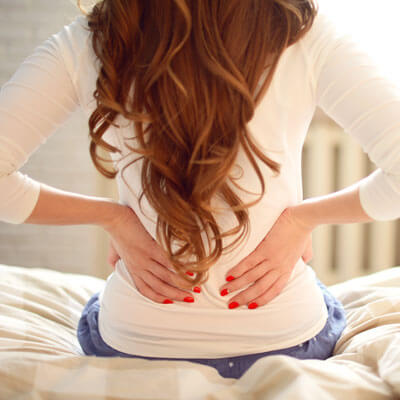 A herniated disc is a condition that can occur anywhere along the spine, but most often in the lower back. It’s sometimes called a protruding, bulging, or ruptured disc. A herniated disc is one of the most common causes of lower back pain and/or leg pain.
A herniated disc is a condition that can occur anywhere along the spine, but most often in the lower back. It’s sometimes called a protruding, bulging, or ruptured disc. A herniated disc is one of the most common causes of lower back pain and/or leg pain.
What Are Some Symptoms?
If you have a herniated disc, you may experience the following:
- Pain that travels into one or both legs
- Tingling or numbness in one or both legs
- Muscle weakness in particular muscles of one or both legs
- Loss of reflexes in one or both legs
Designed to Be Durable
Think of a disc like a shock absorber that contains a bag of fluid. A disc helps absorb shock between two vertebrae in the body and is strongly secured by fibers around it. The fibers surrounding the disc keep the bag of water in the center, allowing the disc to move in a forward, backward and sideways motion, including rotation.
The disc is extremely tough, designed to be unbreakable, and is nourished with very little blood supply. It’s the fluid around the joints that nourish the disc. So given that the disc is supposed to be strong and designed not to break, why does it break?
Reasons Why Discs Break
Application of force
If the force is coming straight down on a disc, there’s compression on this bag of water with enough equal pressure on all sides, and supported by the fibers around-like a shock absorber.
What happens is when you tip the pressure-the force-on one side and do that consistently, the bag of fluid is always pushed in one direction: the interior, posterior, posterior lateral, or anterior lateral. A herniated disc commonly goes posterior lateral; what happens is that constant pressure on the fiber causes the fibers to be weakened.
Poor nutrition and dehydration
Good nutrition is vital for good health, including the health of discs. If someone has poor nutrition, the tissues around the disc are not properly nourished. Inflammation is present, and the whole joint space is dehydrated. The disc won’t be properly nourished and hydrated.
When pressure is constantly applied in one direction, the fiber starts to weaken, and then the disc tears. When that happens, the disc will shift in the direction of the tear. If this condition continues, it can completely tear the fibers. In the worst case, surgery will be needed
Fortunately, chiropractic care may help address herniated discs.
Dr. Siow’s Approach
“To have a healthy spine, the whole spine must move. Our focus in the office is to ensure the entire spine moves healthily,” said Dr. Siow.
She doesn’t just adjust one segment, however. “If a patient comes in with a herniated disc, my goal is to not only reduce their inflammation and pain, but also ensure the hips, knees, ankles and shoulders move right. We want to make sure the whole spine moves properly from a biomechanical standpoint,” Dr. Siow added.
She also offers NetworkSpinal care, which trains the nervous system and brain to correct itself.
CONTACT US »
